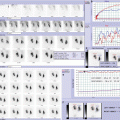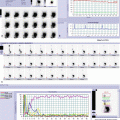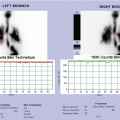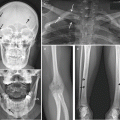Fig. 1.1
Special attitudes and skills for pediatric patient management
Working with pediatric population requires adequate awareness: in order to obtain appropriate acquisition standards, the team approach must be shaped to the child’s mind-set, rather than fitting the child into the paradigm of adult examinations.
In fact, children are not miniature adults and, as well as the normal values of the vital parameters of infants and children are different than adults, even methods of communication should be adequate for their developmental age.
Besides, pediatric patients are children with special health care needs who could have any type of condition that may affect normal growth and development; this may include physical disability, acute or chronic illness, peculiar clinical condition (pain, technological dependency, etc.). During the diagnostic procedure, even when the staff use distraction techniques to hold child still and calm, health care professionals must be ready to manage a possible worsening of the patient’s clinical status (Fig. 1.1).
Taking care of a pediatric patient includes parental management, and the attitude of all staff members must be positive toward the child and parent (or other family components). In “family-centered approach,” the family’s input is the major driving force to achieve a good cooperation of the child and a high degree of satisfaction of parents.
A department structured with colored paintings on the walls, playful environments (equipped with toys, books, video games, or DVDs) and child-friendly spaces could help foster a welcoming accommodation, but it does not replace the right atmosphere that the nuclear medicine staff must be able to create from the first patient approach.
1.2 Accommodate the Child and the Parents
Nurses usually handle the reception of the child and the parent. Based on a first quick observation, it is crucial to define an individual approach evaluating a child’s personal features and familiar or sociocultural influences. In all cases, the first child approach must be slowly and calm in order to set the basis of a good relationship with all the nuclear medicine staff. The reception of pediatric patients must include an initial evaluation of clinical condition to set up an appropriate assistance and monitoring level in case of special health care needs.
From the first moment the child and parent enter the department, all members must be honest with both of them, in order to create a trusting relationship. In the case of both children and adolescents, the staff members must be able to adapt to different patient types, involving them in every moment and explaining the whole procedure in simple terms.
Starting from the first contacts, parents and children must be introduced into the department’s environment by a specific education about correct paths within the department (with particular regard to the use of bathrooms and disposal of radioactive diapers) and explanation of the use of dedicated tools available in the waiting room (bottle warmer, electronic devices, etc.). To avoid the risk of accidental falls, it is necessary to enforce the standards of child safety, inviting the parents to buckle up the stroller and constantly monitoring the baby should not run or climb in the waiting room.
Parents are encouraged to stay with their children throughout every part of the examination (with the exception if the child’s mother is pregnant), emphasizing the importance of their role in supporting the child for a good outcome of the examination. Generally, the idea to perform a scintigraphic examination generates fear in the child and the parent. Professionals in charge of the pediatric patient management have to be adequately trained handling anxiety and situations of emotional tension of child and the parents. This peculiar ability is closely related to a personal attitude (prone to a supportive and empathetic approach) as well as the capability to provide clear information.
To gain the trust of the child, put him at ease and reduce anxiety; one of the most used tricks in pediatrics is entertaining the patient speaking about his everyday life or family members before starting with the diagnostic procedure. Explaining same symptoms by metaphors could be useful to create a direct line of communication (i.e., we usually describe the puncture syringe similar to a mosquito bite or a little pinch).
Providing clear information is also the best form to reduce anxiety for parents. During the interview for the anamnesis and the acquisition of the written informed consent, nuclear medicine physician must explain the entire scintigraphic procedure, stressing the clinical utility within the global diagnostic–therapeutic iter. Providing instructions on how parents can collaborate together with staff is a helpful way to motivate them to be part of the team in order to improve the impact of diagnostic examination on their child.
One of the most difficult steps is minimizing and communicating radiation risk in pediatric nuclear medicine. Generally, parents can understand that their child will undergo an appropriate medical imaging test, but the explanation about radiation risk associated with nuclear medicine examination is always a critical point.
Nuclear medicine practitioners must be able to effectively communicate that the dose range associated with most nuclear medicine procedure results in a low radiation exposure and a very low risk of detrimental health effects. In case of scintigraphy, with a medium or high radiation exposure level, it is necessary to clarify that the potential risk associated to ionizing radiation remains still low compared with the benefits derived by the diagnostic information, unattainable using other imaging procedures.
Depending on the type of nuclear medicine exam, nuclear medicine physicians have to provide adequate radioprotection instructions to avoid undue radiation exposure of other children or pregnant women; in order to reduce global patient radiation exposure, proper indications should be suggested (good hydration with water or whatever is pleasing to the child and frequent urination).
1.3 Administration of Radiopharmaceutical
Depending on the type of nuclear medicine exam, the radiotracer is either injected into the body, swallowed, or inhaled as a gas in order to evaluate the functional information of the organ system being examined. Except for intravenous injections, most nuclear medicine procedures are painless and rarely associated with significant discomfort or side effects.










